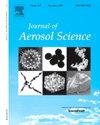Optimized reconstruction of adhesion force distribution from resuspension measurements using the Rock’n’Roll model
IF 3.9
3区 环境科学与生态学
Q2 ENGINEERING, CHEMICAL
引用次数: 0
Abstract
Resuspension, a widely studied phenomenon for decades due to its environmental, industrial, and health impacts, is gaining renewed interest, especially for inhalable particles (smaller than 10 μm) posing health risks. Models describing particle resuspension from surfaces evaluate the fraction of resuspended particles by using their adhesion distribution as input. However, measuring adhesion in the microscale can be a challenging and expensive task, as it requires special skills and instrumentation, such as Atomic Force Microscopy. In this study, we suggest an inverse-by-optimization approach to estimate the adhesion distributions from a measured resuspension curve as an optimization process. Our algorithm utilizes the widely used Rock'n’Roll (RnR) resuspension model to calculate numerical resuspension curves from adhesion distributions. The calculated resuspension curves are compared to a measured resuspension curve based on their degree of agreement, as indicated by the Root Mean Squared Error (RMSE) statistic. The optimization process aims to find a theoretical curve that provides a minimal RMSE value. The parameters that yield the best fit determine the optimal adhesion distribution that represents the particles' interaction with the surface. We evaluated our algorithm using the dataset from Reeks and Hall (2001), which enabled us to accurately assess the adhesion distribution they had employed. Then the algorithm was used to estimate the adhesion distribution from resuspension measurements that we conducted for this study. These were performed in a specially designed wind duct where 8 μm diameter glass colloids of were resuspended from a glass surface. The application of this algorithm to our measured resuspension curves resulted in an adhesion distribution with a median adhesion force value of ∼1400 nN. This value lies within the range of reported measurements of adhesion between glass colloidal spheres and glass surface.
求助全文
约1分钟内获得全文
求助全文
来源期刊

Journal of Aerosol Science
环境科学-工程:化工
CiteScore
8.80
自引率
8.90%
发文量
127
审稿时长
35 days
期刊介绍:
Founded in 1970, the Journal of Aerosol Science considers itself the prime vehicle for the publication of original work as well as reviews related to fundamental and applied aerosol research, as well as aerosol instrumentation. Its content is directed at scientists working in engineering disciplines, as well as physics, chemistry, and environmental sciences.
The editors welcome submissions of papers describing recent experimental, numerical, and theoretical research related to the following topics:
1. Fundamental Aerosol Science.
2. Applied Aerosol Science.
3. Instrumentation & Measurement Methods.
 求助内容:
求助内容: 应助结果提醒方式:
应助结果提醒方式:


